A First Look at Internal Waves in the Great Barrier Reef Lagoon
Abstract
:1. Introduction
2. Materials and Methods
2.1. Study Area Characteristics
2.2. Satellite Imagery
2.3. Approach
3. Results
3.1. Results of Imagery Search
3.2. Case Studies
3.2.1. Reefs 1–3 (Low Tide)
3.2.2. Reefs 1–3 (Mid-Flood)
3.2.3. Reefs 1–3 (High Tide)
3.2.4. Reefs 4 and 5
4. Discussion
4.1. Internal Wave Generation
4.1.1. Flood-Tide Scenario
4.1.2. Frontal Intrusion as a Generating Mechanism
4.2. Possible Ecological Significance
5. Conclusions
- Favorable conditions for the occurrence of internal waves are a shallow stratification (thermocline centered at about 8 m depth) and low wind (usually 4 m/s or less).
- Those conditions may not be sufficient, however, as some favorable days do not have visible internal wave signatures.
- At least some internal wave packets appear to be generated locally through a link with tidally forced submesoscale jets and vortices, but the actual mechanism generating the waves is unclear.
- As the internal waves occur during austral spring and summer, they may play some role in the dispersion and transport of cyanobacteria and planktonic larvae.
Supplementary Materials
Funding
Data Availability Statement
Acknowledgments
Conflicts of Interest
References
- Wolanski, E.; Kingsford, M.; Lambrechts, J.; Marmorino, G. The Physical Oceanography of the Great Barrier Reef: A Review. In Oceanographic Processes of Coral Reefs Physical and Biological Links in the Great Barrier Reef, 2nd ed.; Wolanski, E., Kingsford, M.J., Eds.; CRC Press: Boca Raton, FL, USA, 2023; Chapter 2; 26p. [Google Scholar] [CrossRef]
- Luick, J.L.; Mason, L.; Hardy, T.; Furnas, M.J. Circulation in the Great Barrier Reef Lagoon using numerical tracers and in situ data. Cont. Shelf Res. 2007, 27, 757–778. [Google Scholar] [CrossRef]
- Mao, Y.; Ridd, P.V. Sea surface temperature as a tracer to estimate cross-shelf turbulent diffusivity and flushing time in the Great Barrier Reef lagoon. J. Geophys. Res. Ocean. 2015, 120, 4487–4502. [Google Scholar] [CrossRef]
- Delandmeter, P.; Lambrechts, J.; Marmorino, G.O.; Legat, V.; Wolanski, E.; Remacle, J.F.; Chen, W.; Deleersnijder, E. Submesoscale tidal eddies in the wake of coral islands and reefs: Satellite data and numerical modelling. Ocean Dyn. 2017, 67, 897–913. [Google Scholar] [CrossRef]
- Jackson, C.R.; da Silva, J.C.B.; Jeans, G. The generation of nonlinear internal waves. Oceanography 2012, 25, 108–123. [Google Scholar] [CrossRef]
- Marmorino, G. Investigation of Turbulent Tidal Flow in a Coral Reef Channel Using Multi-Look WorldView-2 Satellite Imagery. Remote Sens. 2022, 14, 783. [Google Scholar] [CrossRef]
- Jackson, C.R.; da Silva, J.C.B.; Jeans, G.; Alpers, W.; Caruso, M.J. Nonlinear internal waves in synthetic aperture radar imagery. Oceanography 2013, 26, 68–79. [Google Scholar] [CrossRef]
- Maxworthy, T. On the formation of nonlinear internal waves from the gravitational collapse of mixed regions in two and three dimensions. J. Fluid Mech. 1980, 96, 47–64. [Google Scholar] [CrossRef]
- Bourgault, D.; Galbraith, P.S.; Chavanne, C. Generation of internal solitary waves by frontally forced intrusions in geophysical flows. Nat. Commun. 2016, 7, 13606. [Google Scholar] [CrossRef] [PubMed]
- Blondeau-Patissier, D.; Brando, V.; Lønborg, C.; Leahy, S.; Dekker, A. Phenology of Trichodesmium spp. blooms in the Great Barrier Reef lagoon, Australia, from the ESAMERIS 10-year mission. PLoS ONE 2018, 13, e0208010. [Google Scholar] [CrossRef] [PubMed]
- Oliver, J.K.; Willis, B.L. Coral-spawn slicks in the Great Barrier Reef: Preliminary observations. Mar. Biol. 1987, 94, 521–529. [Google Scholar] [CrossRef]
- Pattiaratchi, C. Physical oceanographic aspects of the dispersal of coral spawn slicks: A review. Bio-Phys. Mar. Larval Dispersal 1994, 45, 89–105. [Google Scholar]
- Wyatt, A.S.J.; Leichter, J.J.; Toth, L.T.; Miyajima, T.; Aronson, R.B.; Nagata, T. Heat accumulation on coral reefs mitigated by internal waves. Nat. Geosci. 2020, 13, 28–34. [Google Scholar] [CrossRef]
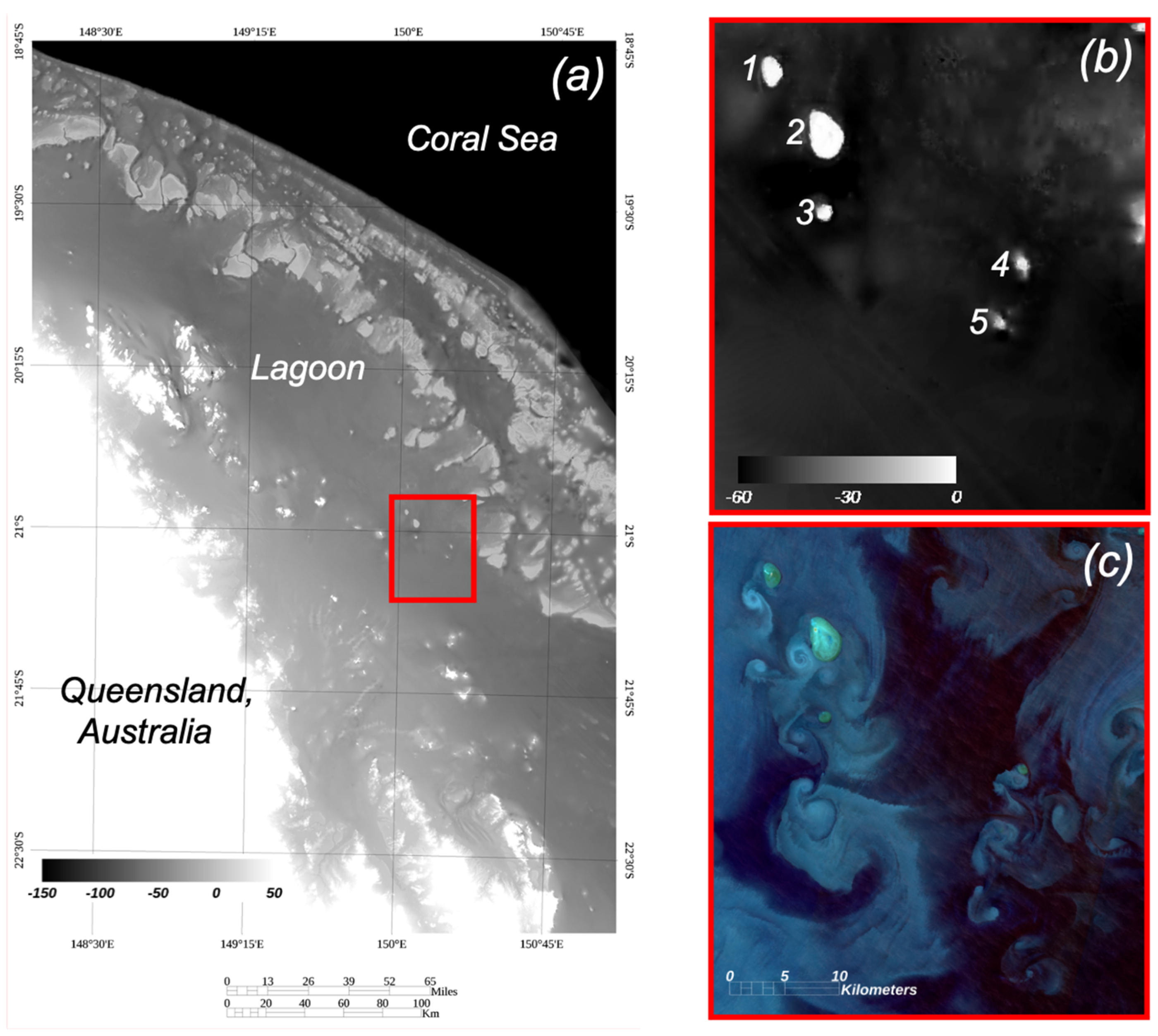
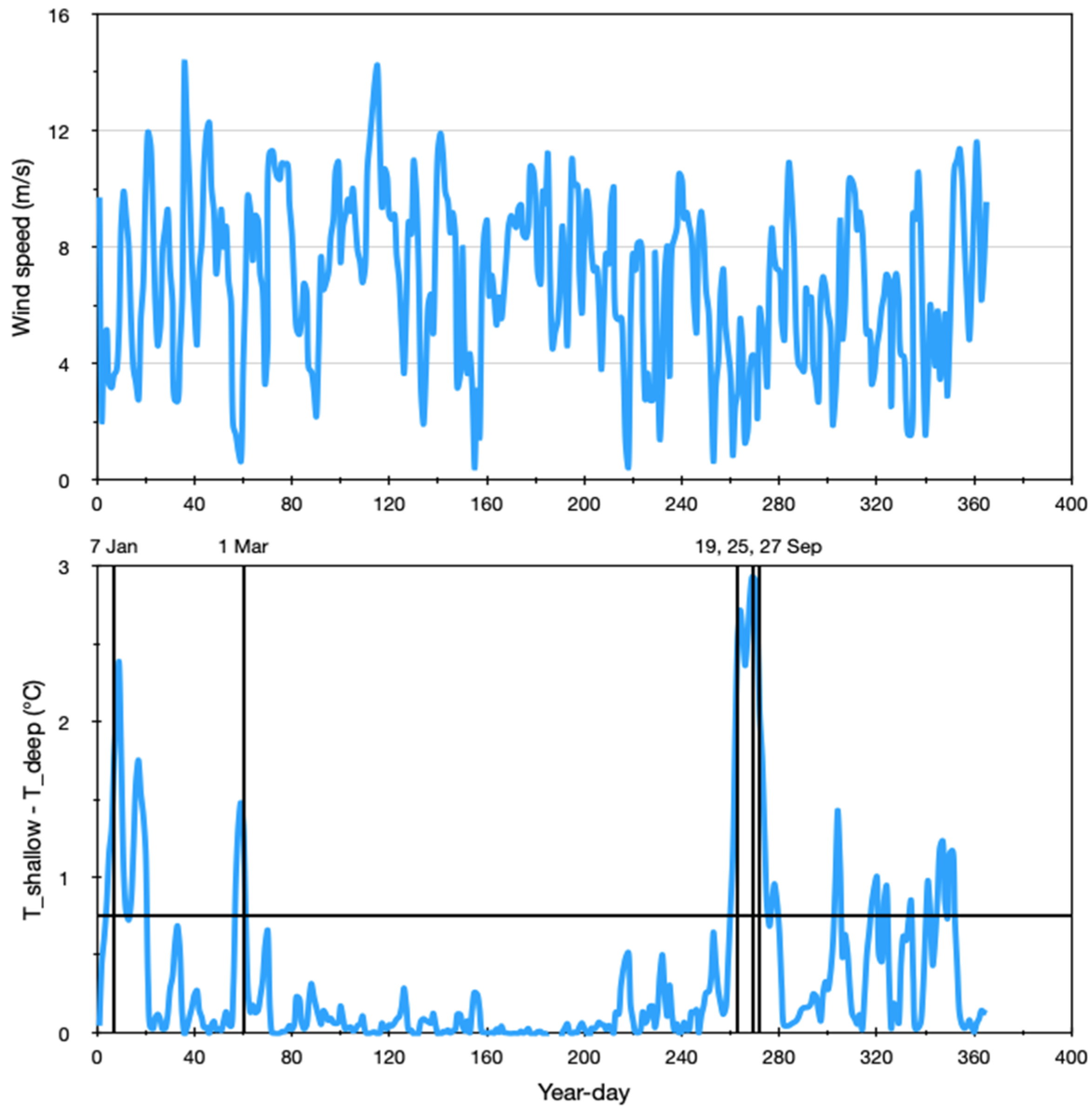
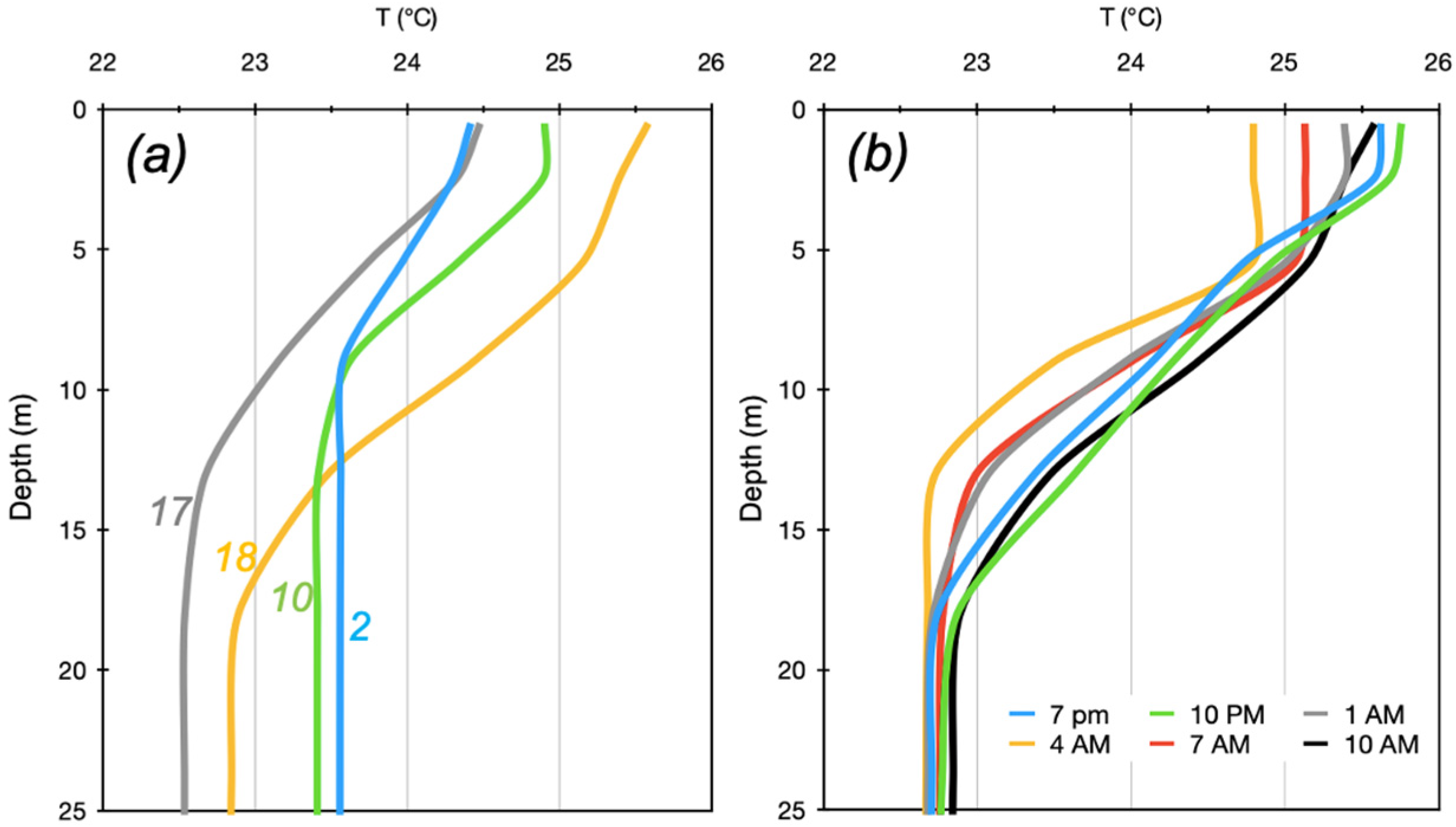
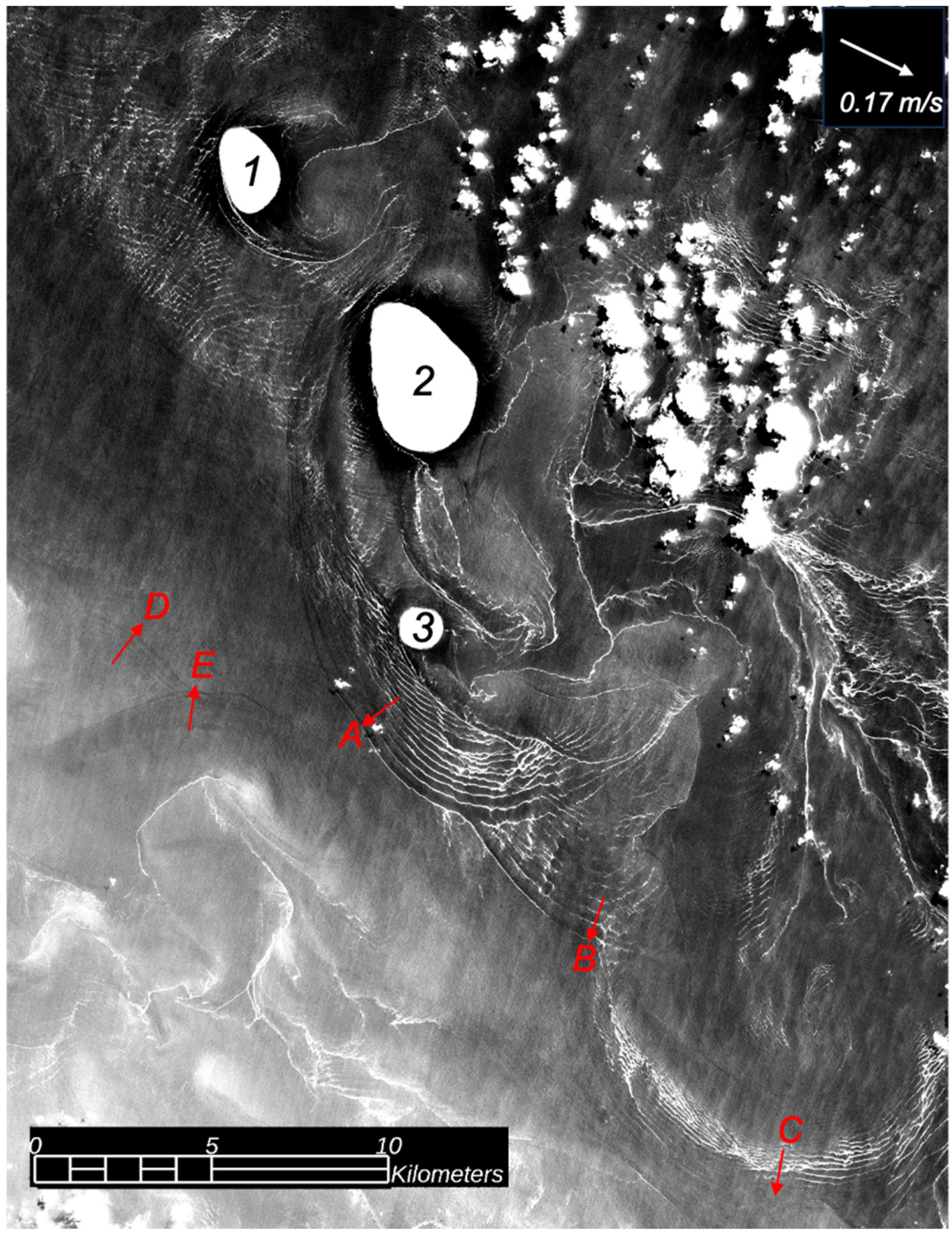
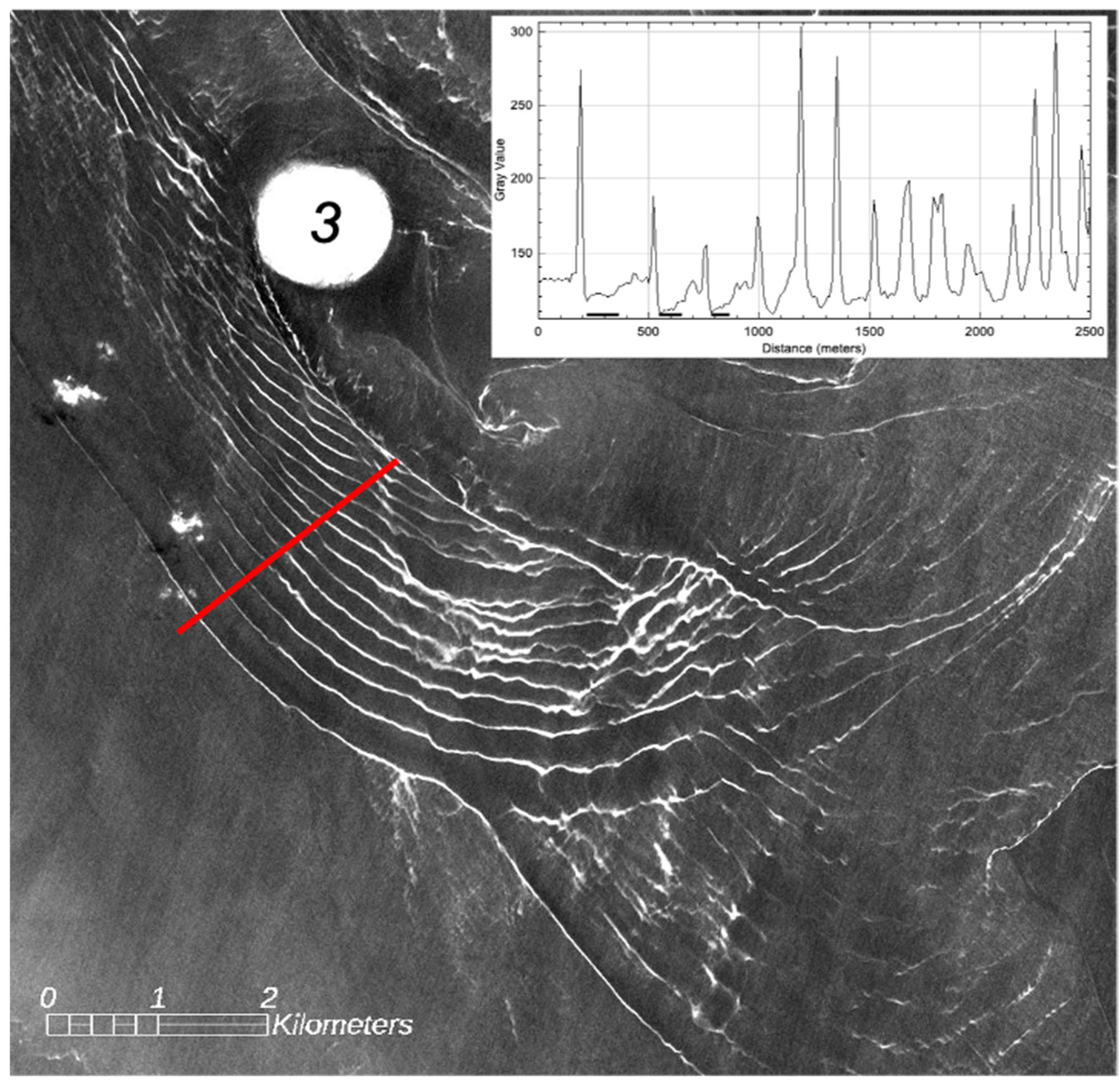
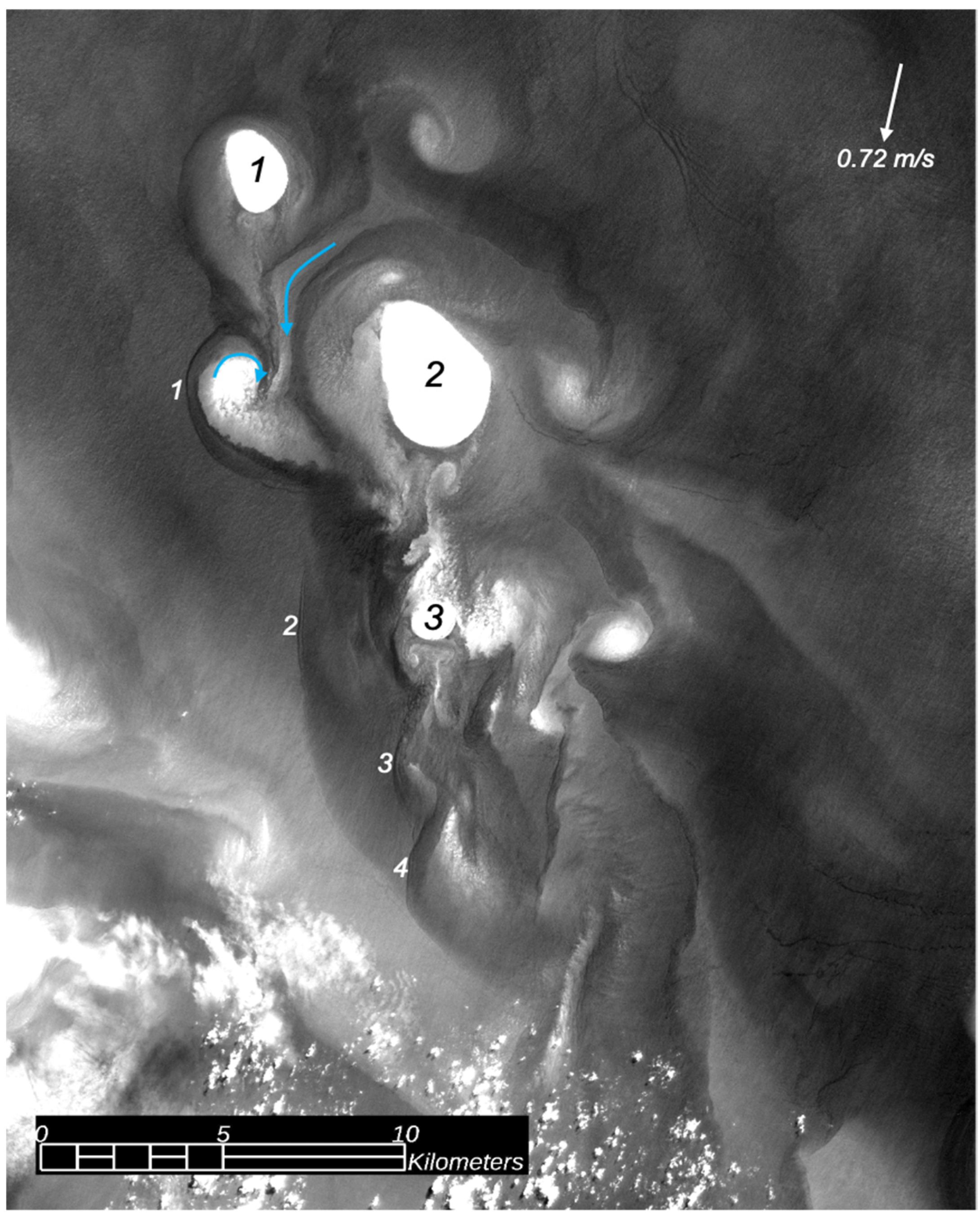
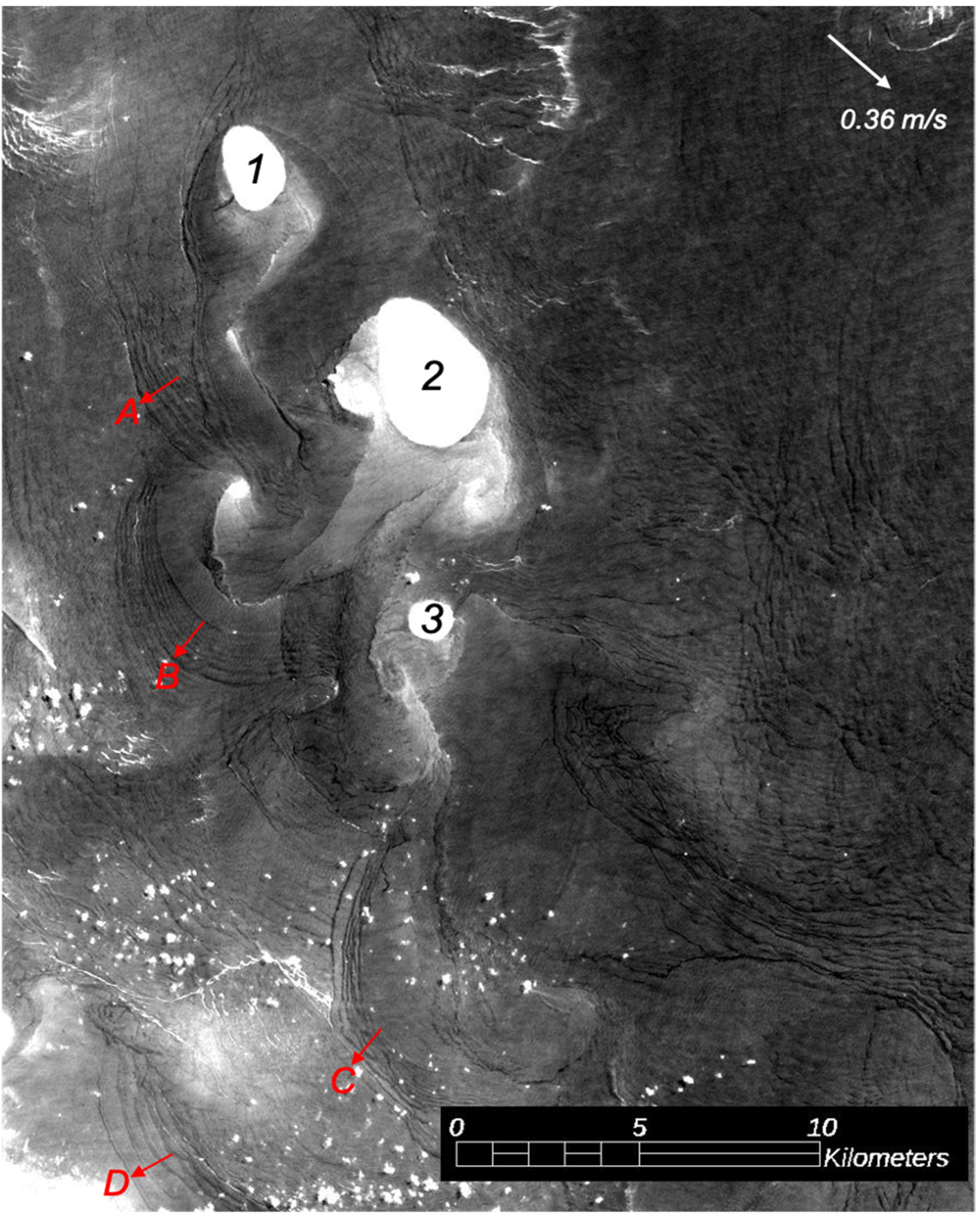
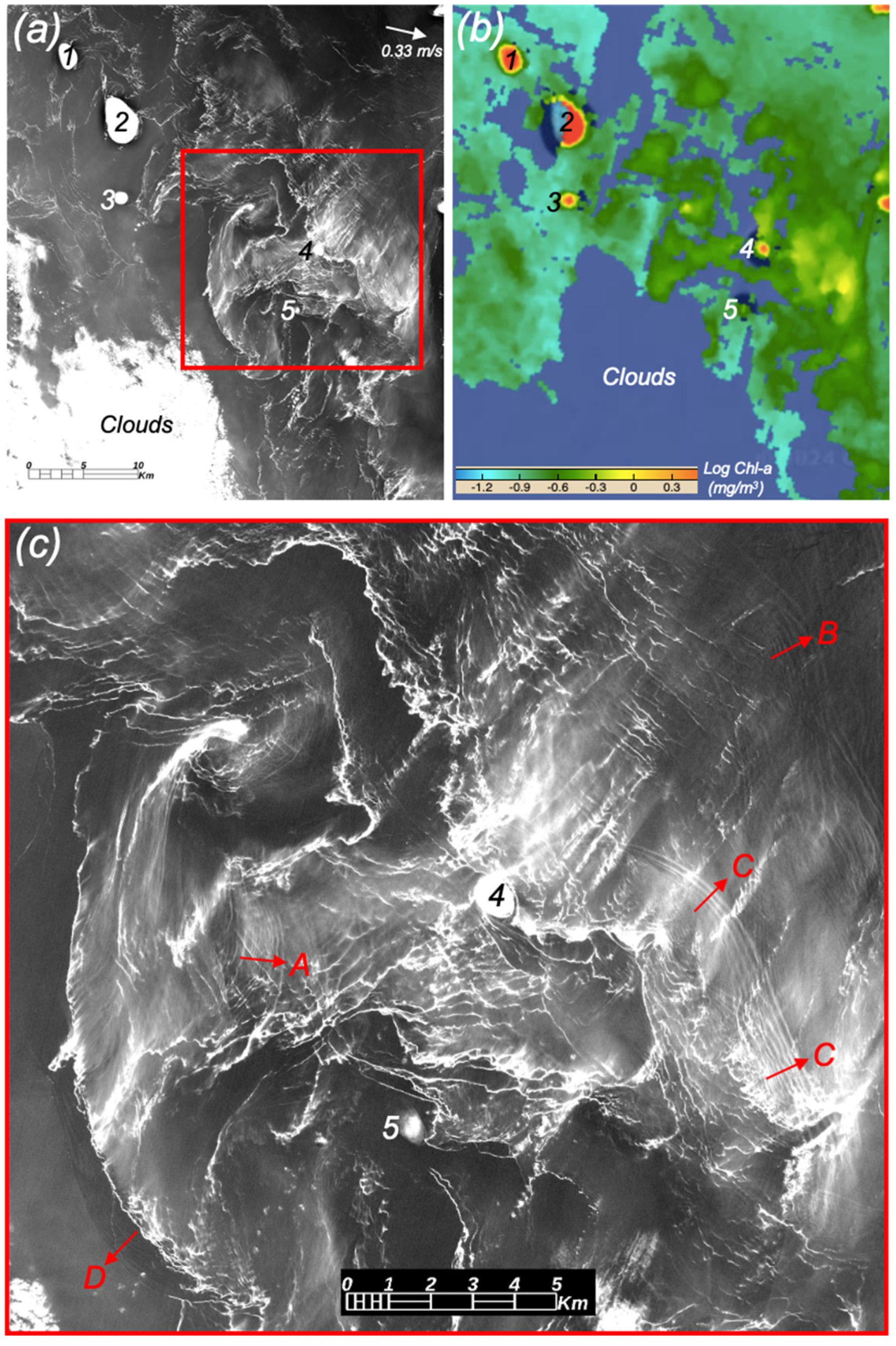
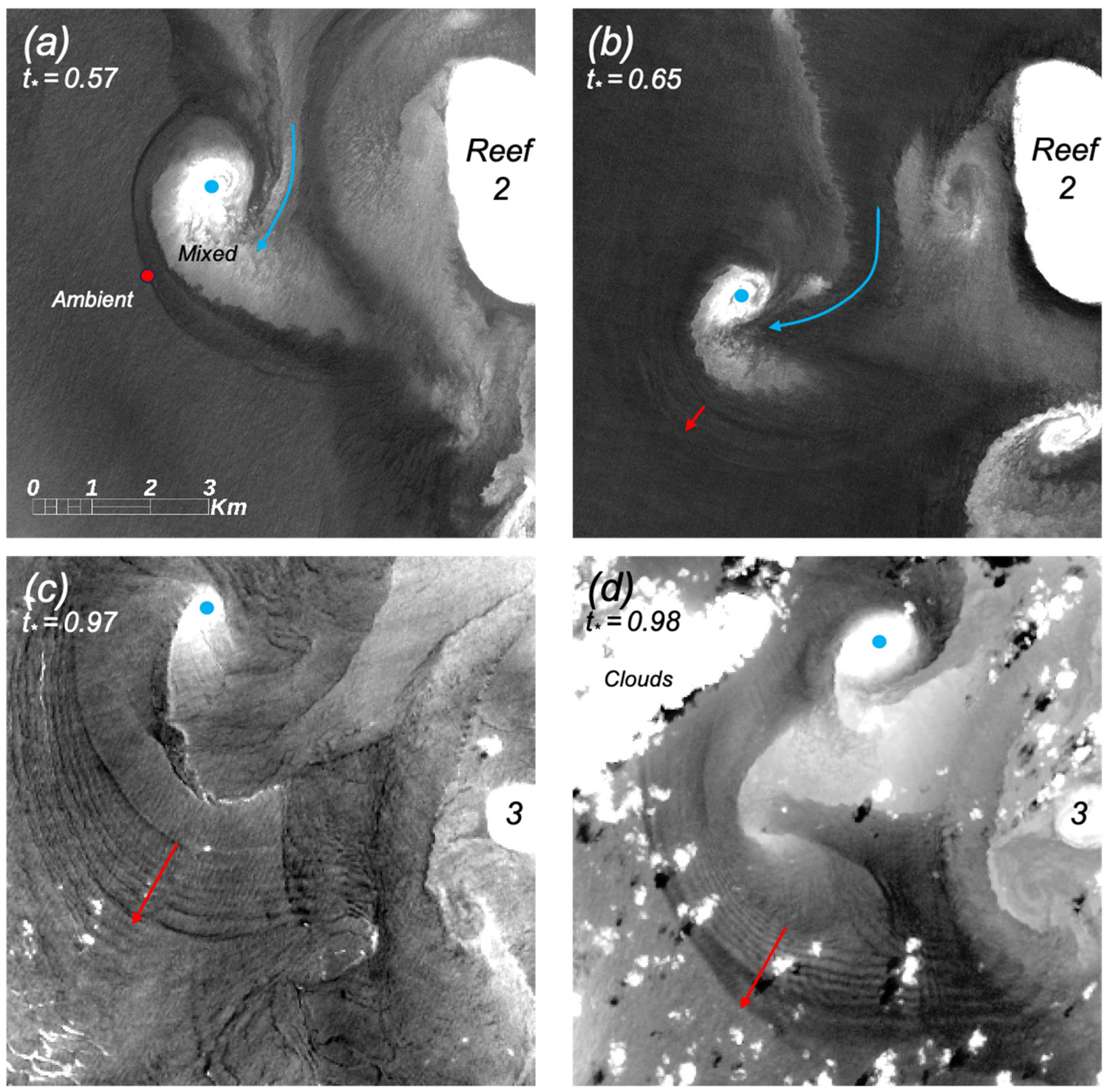
| Case | Satellite | Overpass Time [AEST] | Tidal Phase | Current [m/s] | Wind [m/s] | ΔT [°C] | Figure |
|---|---|---|---|---|---|---|---|
| 1 | Landsat-8 | 2015 Aug 29 09:58 | High water | 0.40 | 4.1 | 0.43 | 9 |
| 2 | Sentinel-2 | 20 September 2016 10:12 | Flood | 0.72 | 3.2 | 0.85 | 6,9 |
| 3 | Landsat-8 | 8 December 2017 09:59 | Flood | 0.64 | 3.5 | 1.45 | |
| 4 | Sentinel-2 | 20 October 2018 10:11 | Ebb | 0.29 | 3.4 | 1.01 | |
| 5 | Sentinel-2 | 12 February 2019 10:13 | Low water | 0.42 | 4.8 | 1.07 | |
| 6 | Landsat-8 | 13 February 2019 09:59 | Ebb | 0.34 | 3.0 | 1.34 | |
| 7 | Sentinel-2 | 14 March 2019 10:22 | Low water | 0.33 | 2.7 | 0.75 | |
| 8 | Sentinel-2 | 23 January 2020 10:13 | High water | 0.36 | 3.8 | 2.46 | |
| 9 | Sentinel-2 | 15 August 2020 10:13 | Ebb | 0.55 | 2.6 | 0.54 | |
| 10 | Sentinel-2 | 24 September 2020 10:13 | Low water | 0.17 | 1.0 | 1.49 | 4,5 |
| 11 | Sentinel-2 | 23 December 2020 10:13 | Ebb | 0.35 | 2.8 | 1.38 | |
| 12 | Sentinel-2 | 9 October 2021 10:13 | Flood | 0.70 | 5.4 | 0.77 | 9 |
| 13 | Landsat-9 | 11 December 2021 09:59 | Low water | 0.28 | 2.5 | 3.53 | |
| 14 | Sentinel-1 | 24 December 2021 05:28 | Low water | 0.16 | 2.3 | 1.25 | S1 |
| 15 | Sentinel-2 | 7 January 2022 10:13 | Flood | 0.67 | 2.3 | 1.58 | |
| 16 | Landsat-9 | 1 March 2022 09:59 | High water | 0.26 | 2.8 | 1.20 | |
| 17 | Sentinel-2 | 19 September 2022 10:13 | Ebb | 0.33 | 1.8 | 1.80 | 8 |
| 18 | Landsat-9 | 25 September 2022 09:59 | High water | 0.36 | 4.0 | 2.57 | 7,9 |
| 19 | Sentinel-2 | 27 September 2022 10:23 | Flood | 0.63 | 3.6 | 2.54 |
Disclaimer/Publisher’s Note: The statements, opinions and data contained in all publications are solely those of the individual author(s) and contributor(s) and not of MDPI and/or the editor(s). MDPI and/or the editor(s) disclaim responsibility for any injury to people or property resulting from any ideas, methods, instructions or products referred to in the content. |
© 2024 by the author. Licensee MDPI, Basel, Switzerland. This article is an open access article distributed under the terms and conditions of the Creative Commons Attribution (CC BY) license (https://creativecommons.org/licenses/by/4.0/).
Share and Cite
Marmorino, G. A First Look at Internal Waves in the Great Barrier Reef Lagoon. Remote Sens. 2024, 16, 2180. https://doi.org/10.3390/rs16122180
Marmorino G. A First Look at Internal Waves in the Great Barrier Reef Lagoon. Remote Sensing. 2024; 16(12):2180. https://doi.org/10.3390/rs16122180
Chicago/Turabian StyleMarmorino, George. 2024. "A First Look at Internal Waves in the Great Barrier Reef Lagoon" Remote Sensing 16, no. 12: 2180. https://doi.org/10.3390/rs16122180





